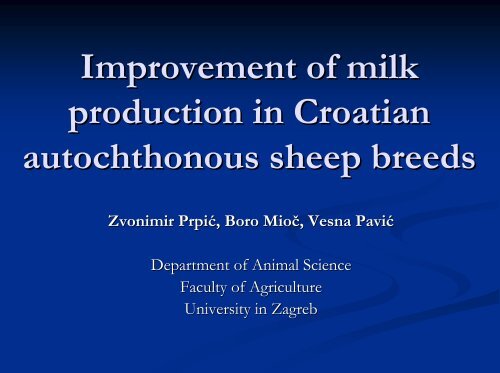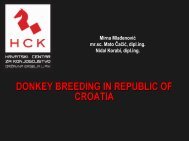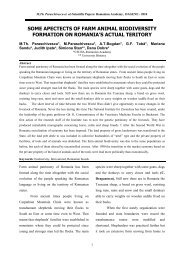Improvement of milk production in Croatian autochthonous ... - dagene
Improvement of milk production in Croatian autochthonous ... - dagene
Improvement of milk production in Croatian autochthonous ... - dagene
- No tags were found...
Create successful ePaper yourself
Turn your PDF publications into a flip-book with our unique Google optimized e-Paper software.
<strong>Improvement</strong> <strong>of</strong> <strong>milk</strong><strong>production</strong> <strong>in</strong> <strong>Croatian</strong><strong>autochthonous</strong> sheep breedsZvonimir Prpić, , Boro Mioč, , Vesna PavićDepartment <strong>of</strong> Animal ScienceFaculty <strong>of</strong> AgricultureUniversity <strong>in</strong> Zagreb
Production <strong>of</strong> sheep <strong>milk</strong> <strong>in</strong> Croatia Primarilyfor meat <strong>production</strong> only 10–12% 12% sheep are bred for <strong>milk</strong> ( about 70 000 animals) Grow<strong>in</strong>g <strong>in</strong>terest for <strong>production</strong> and process<strong>in</strong>g <strong>of</strong>sheep <strong>milk</strong> 2008 = 2 553 000 L (+36%) 2004 = 1 536 000 L Traditional cheese <strong>production</strong> (on familly farms or<strong>in</strong>dustrially)Dagene, Annual Meet<strong>in</strong>g, May 2009,Zagreb, Croatia
Sheep <strong>milk</strong> <strong>production</strong> Milk <strong>production</strong> based on<strong>autochthonous</strong> sheepbreeds Located<strong>in</strong> the Adriaticcoastal area 7 <strong>autochthonous</strong> breeds >60% <strong>of</strong> total sheeppopulationDagene, Annual Meet<strong>in</strong>g, May 2009,Zagreb, Croatia
Autochthonous sheep breedscomb<strong>in</strong>ed <strong>production</strong> characteristics(meat-<strong>milk</strong><strong>milk</strong>-wool)low yield<strong>in</strong>g capacityadapted to karstvery good utilization <strong>of</strong>poor vegetationcapability for long distantwalk<strong>in</strong>gresistant to drought periodsand hot summer temperaturesDagene, Annual Meet<strong>in</strong>g, May 2009,Zagreb, Croatia
Breeds for <strong>milk</strong><strong>production</strong> Pag sheep most important breed for <strong>milk</strong><strong>production</strong> total population: 30 000-35 000heads 2 500 heads under breed<strong>in</strong>gprogrammeDagene, Annual Meet<strong>in</strong>g, May 2009,Zagreb, Croatia
Island Pag >50% <strong>of</strong> total amounts <strong>of</strong>purchased and processed<strong>milk</strong> <strong>in</strong> Croatia 83% <strong>of</strong> island is covered withkarst specific botanical composition <strong>of</strong>pastures with numerous aromaticplants → special organolepticproperties <strong>of</strong> <strong>milk</strong> and meat all <strong>milk</strong> is processed <strong>in</strong>to cheese(Pag cheese)Dagene, Annual Meet<strong>in</strong>g, May 2009,Zagreb, Croatia
Table 1: Milk <strong>production</strong> characteristics <strong>of</strong>Pag sheep (n=1 501)Lactationlength(days)Length <strong>of</strong>suckl<strong>in</strong>gperiod(days)Length <strong>of</strong><strong>milk</strong><strong>in</strong>gperiod(days)Total<strong>milk</strong>yield(kg)Fat(%)Prote<strong>in</strong>s(%)16229133136,27,696,59Dagene, Annual Meet<strong>in</strong>g, May 2009,Zagreb, Croatia
Breeds for <strong>milk</strong> <strong>production</strong> Istrian sheep highest <strong>milk</strong> yield total population: 2 046 heads different exteriorcharacteristics from other<strong>Croatian</strong> breeds <strong>in</strong>fluence <strong>of</strong> the Bergamosheep typical dairy breedcharacteristicsDagene, Annual Meet<strong>in</strong>g, May 2009,Zagreb, Croatia
Table 2: Milk <strong>production</strong> characteristics <strong>of</strong>Istrian sheep (n=683)Lactationlength(days)Length <strong>of</strong>suckl<strong>in</strong>gperiod(days)Length <strong>of</strong><strong>milk</strong><strong>in</strong>gperiod(days)Total<strong>milk</strong>yield(kg)Fat(%)Prote<strong>in</strong>s(%)18149132225,27,026,14Dagene, Annual Meet<strong>in</strong>g, May 2009,Zagreb, Croatia
Today’s s challenges Exclusive selection on <strong>milk</strong>yield “baggy” udders with teatsplaced more horrizontaly more difficult to <strong>milk</strong> bymach<strong>in</strong>e more susceptible to mastitis hygenic quality <strong>of</strong> <strong>milk</strong> because traditional cheese<strong>production</strong> is ma<strong>in</strong>ly based onraw, termically non treated <strong>milk</strong>Dagene, Annual Meet<strong>in</strong>g, May 2009,Zagreb, Croatia
Functional traits related toudder udder morphology traits objective udder measurements implementation <strong>of</strong> more effective l<strong>in</strong>ear evaluationsystem (9-po<strong>in</strong>t l<strong>in</strong>ear scale) udder health impov<strong>in</strong>g udder health - selection based on <strong>milk</strong> SCC precondition: determ<strong>in</strong>ation <strong>of</strong> physiological andpathological tresholds <strong>of</strong> <strong>in</strong>dividual SCCDagene, Annual Meet<strong>in</strong>g, May 2009,Zagreb, Croatia
Dagene, Annual Meet<strong>in</strong>g, May 2009,Zagreb, Croatia




